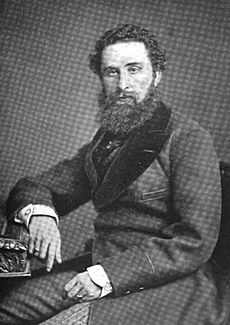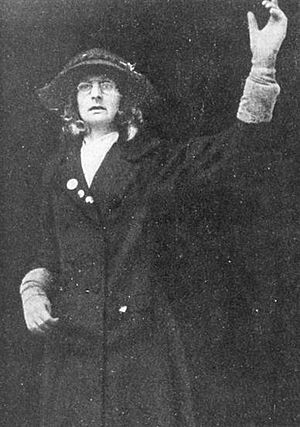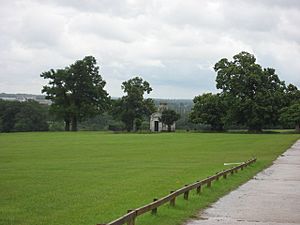Lady Constance Bulwer-Lytton facts for kids
Quick facts for kids
Lady Constance Bulwer-Lytton
|
|
|---|---|
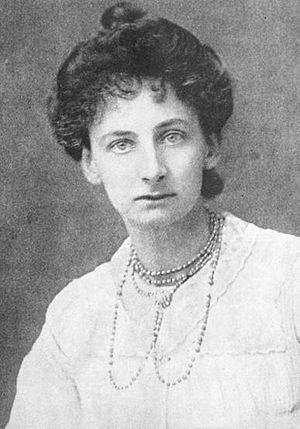 |
|
| Born | 12 February 1869 Vienna, Austria
|
| Died | 2 May 1923 (aged 54) London, England
|
| Resting place | Lytton Mausoleum, Knebworth Park |
| Nationality | British |
| Other names | Jane Warton |
| Occupation | Suffragette |
| Parent(s) | Robert Bulwer-Lytton, 1st Earl of Lytton Edith Villiers |
Lady Constance Georgina Bulwer-Lytton (born February 12, 1869 – died May 2, 1923) was an important British suffragette. She was a writer, speaker, and fought for prison reform and women's right to vote. She often used the name Jane Warton to avoid special treatment when she was arrested for her protests.
Constance was born into a very wealthy and powerful family in Britain. But she chose to leave that life behind. She joined the Women's Social and Political Union (WSPU). This was the most active group of suffragettes. They strongly campaigned for "Votes for Women."
She was put in prison four times. One time, she was in Walton gaol in Liverpool. She pretended to be "Jane Warton," a regular London seamstress. This was so she wouldn't get special treatment because of her famous family. While in prison, she went on a hunger strike. This meant she refused to eat. The prison authorities then force-fed her.
Constance wrote many things about women's rights. She wrote articles for The Times newspaper. She also wrote a book about her experiences called Prisons and Prisoners in 1914.
Constance never married. Her mother did not let her marry a man from a "lower social class." Constance refused to marry anyone else.
Her health suffered greatly from her time in prison. She had a heart attack and a stroke. Many believe this led to her early death at age 54.
Contents
Early Life and Family

Constance Lytton was the third of seven children. Her parents were Robert Bulwer-Lytton, 1st Earl of Lytton and Edith Villiers. She spent some of her early years in India. Her father was the Governor-General there. He announced that Queen Victoria was the Empress of India.
Constance had several brothers and sisters:
- Edward Rowland John Bulwer-Lytton (1865–1871)
- Lady Elizabeth Edith "Betty" Bulwer-Lytton (1867–1942). She married Gerald Balfour, whose brother was future Prime Minister Arthur Balfour.
- Henry Meredith Edward Bulwer-Lytton (1872–1874)
- Lady Emily Bulwer-Lytton (1874–1964). She married the architect Edwin Lutyens.
- Victor Bulwer-Lytton, 2nd Earl of Lytton (1876–1947).
- Neville Bulwer-Lytton, 3rd Earl of Lytton (1879–1951).
In India, governesses taught Constance at home. She reportedly had a lonely childhood. She met Winston Churchill in India. Even though she grew up among famous artists and politicians, she did not like the aristocratic way of life. After her father died, she stayed home to care for her mother.
Constance remained unmarried. In 1892, her mother stopped her from marrying a man from a "lower social order." Constance waited for years for her mother to change her mind. But she refused to marry anyone else.
In 1897, her aunt, Theresa Earle, wrote a gardening guide. Constance helped her by typing some of the text. The book sold very well. Constance even added a section on Japanese flower arranging in a later edition.
Fighting for Women's Vote
Constance's life began to change in 1905. She received £1,000 from her godmother's estate. She gave this money to help bring back Morris dancing. Her brother suggested she give it to the Esperance Club. This club was for working-class girls. It taught them singing and dancing, including Morris dancing. Emmeline Pethick-Lawrence and Mary Neal started the Esperance club. They wanted to help girls working in the London dress trade.
Joining the Suffragette Cause (1908)
Between 1908 and 1909, Constance Lytton fully joined the suffragette movement. On September 10, 1908, she wrote about meeting suffragettes. She learned about problems in prisons. This made her even more interested in prison reform. She planned to meet the inspector of Holloway prison. She also wanted to join a breakfast with released suffragette prisoners.
She met other suffragettes, like Annie Kenney. On October 14, 1908, she wrote to her mother. She told her that she wanted to help the suffragettes. She asked if she could help them convince the government to treat suffragettes as political prisoners. They were not common criminals.
In her book Prisons and Prisoners, she explained her decision. Women had tried peaceful ways to influence the government. But petitions and protests did not work. In January 1909, she decided to join the Women's Social and Political Union (WSPU). She gave speeches across the country. She also used her family connections to campaign in Parliament. She even wrote to the Home Secretary. She asked him to release Emmeline Pankhurst and Christabel Pankhurst from prison.
On October 8, 1909, Constance was in Newcastle. She decided to throw a stone at a car carrying David Lloyd George. She aimed low to avoid hurting anyone. She shouted, "How can you, who say you back the women's cause, stay on in a government which refuses them the vote?"
Imprisonment in Holloway (1909)
Constance was imprisoned in Holloway prison twice in 1909. This was after she protested at the House of Commons. But she had a weak heart. So, she spent most of her time in the prison hospital. When the authorities found out who she was, they released her. They knew she was Lord Lytton's daughter. The British government also worried that her health problems and hunger strike could make her a martyr.
Constance was angry about this unfair treatment. She wrote to the Liverpool Daily Post in October 1909. She complained about the special treatment she received.
In her book Prisons and Prisoners, she wrote to her mother from prison. She said that prisons had been her "hobby." She felt a strong connection to prisoners. She believed that prisons caused harm and wasted chances for good.
Imprisonment in Newcastle (1909)
In October 1909, Constance Lytton was arrested again in Newcastle. She had thrown a stone wrapped in paper. The paper had a message for Lloyd George. It said, "Rebellion against tyranny is obedience to God – Deeds, not words." This was her response to the government's new policy. They were force-feeding suffragettes who were on hunger strike.
Jane Warton in Liverpool (1910)
In January 1910, Constance believed that poorer prisoners were treated worse. So, she disguised herself as a working-class London seamstress. Her name was Jane Warton. In disguise, she spoke at an event in Liverpool. She led a march to the Prison Governor's house. They demanded that force-feeding be stopped in Liverpool.
She was arrested after rocks were thrown at an MP's car. She was sent to Walton gaol for 14 days of 'hard labour'. She was force-fed 8 times. After her release, she was very weak. But she wrote about her experience for The Times and Votes for Women. She also gave speeches about the harsh conditions suffragette prisoners faced. Her speeches and letters are thought to have helped end force-feeding.
Constance wrote about her "Jane Warton" experience in Prisons and Prisoners. She explained how she chose the name "Jane Warton." She wanted a simple name that wouldn't draw attention. "Jane" reminded her of Joan of Arc.
She described her disguise:
- She cut her hair short.
- She bought a tweed hat, a long green coat, and woollen accessories.
- She wore pince-nez spectacles.
- She removed her own initials from her clothes. She planned to sew on "J.W." but ran out of time.
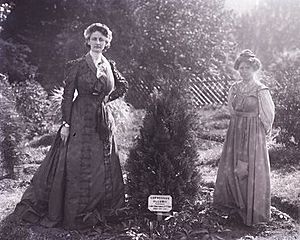
She also wrote about her arrest: She had small, flat stones wrapped in paper. When the police arrested her, she dropped the stones. She apologized to a man whose shoulder one stone touched. Two policemen then took her to the police station.
The Hardship of Force-feeding
Constance described the force-feeding process. A doctor threatened to feed her through her nose if she resisted. He forced a gag between her teeth. Then, he put a long, wide tube down her throat. The tube caused intense irritation. She choked as it went down. Food was poured in quickly. She became sick, but the wardresses held her down. The doctor slapped her cheek as he left. He seemed to think she was faking her distress.
She then heard force-feeding happening in the next cell. She was sure it was Elsie Howey. After it was over, she tapped on the wall and called out, "No surrender!" Elsie's voice answered, "No surrender." This showed their strong spirit.
Constance's health got worse. She had a heart attack in August 1910. Then she had several strokes. These strokes paralyzed the right side of her body. But she did not give up. She used her left hand to write Prisons and Prisoners (1914). This book became very important for prison reform.
The WSPU gave Constance Lytton a Hunger Strike Medal for her bravery.
Later Years (1911 onwards)
In June 1911, Constance's brother received a letter. It was from the local school headmistress and 41 other "Suffrage women of Knebworth." They thanked the Lyttons for their work for the cause. Seventeen of them were WSPU members, including Constance's cook. Nine were from the non-militant NUWSS.
In November 1911, Constance Lytton was imprisoned in Holloway for the fourth time. This was after she broke windows at the Houses of Parliament or a Post Office. However, prison conditions had improved. She said, "all was civility; it was unrecognisable from the first time I had been there." Suffragettes were now treated as political prisoners.
In January 1918, Parliament passed a law. It gave women over 30 the right to vote if they were married to a property owner or owned property themselves.
Death and Remembrance
Endowed with a celestial sense of humour, boundless sympathy, and rare musical talent, she devoted the later years of her life to the political enfranchisement of women and sacrificed her health and talents in helping to bring victory to this cause.
Constance Lytton never fully recovered from her prison treatment and strokes. Her mother cared for her at Homewood, a house designed by her brother-in-law, Edwin Lutyens. She died in 1923, at age 54. This was just days after she moved to a flat in London. She had hoped to start an active life again.
At her funeral, purple, white, and green suffragette colours were placed on her coffin. Her ashes are in the family mausoleum at Knebworth Park.
Important Dates
- 1869: Lady Constance Georgina Lytton is born.
- 1880: Her family leaves India.
- 1908: She receives £1000 from her godmother and meets important suffragettes.
- 1909: She officially joins the WSPU.
- 1909: She is imprisoned for the first time in February.
- 1909: Her pamphlet 'No Votes for Women' is published.
- 1909: She is imprisoned for the second time in Holloway in October.
- 1910: She disguises herself as Jane Warton. She is imprisoned for the third time in Walton Gaol, Liverpool. She is force-fed many times.
- 1910: She writes about her experiences in The Times.
- 1911: She is imprisoned for the fourth time in Holloway in November.
- 1912: She has a stroke. She never fully recovers but continues to write Prisons and Prisoners.
- 1914: Prisons and Prisoners is published.
- 1918: The Representation of the People Act 1918 gives the vote to all men and to women over 30.
- 1923: Constance Lytton dies at age 54.
- 1928: The Representation of the People Act 1928 gives women the right to vote on the same terms as men.
Archives
Letters written by Constance Lytton are kept at The Women's Library at London Metropolitan University.
See also
 In Spanish: Lady Constance Bulwer-Lytton para niños
In Spanish: Lady Constance Bulwer-Lytton para niños


